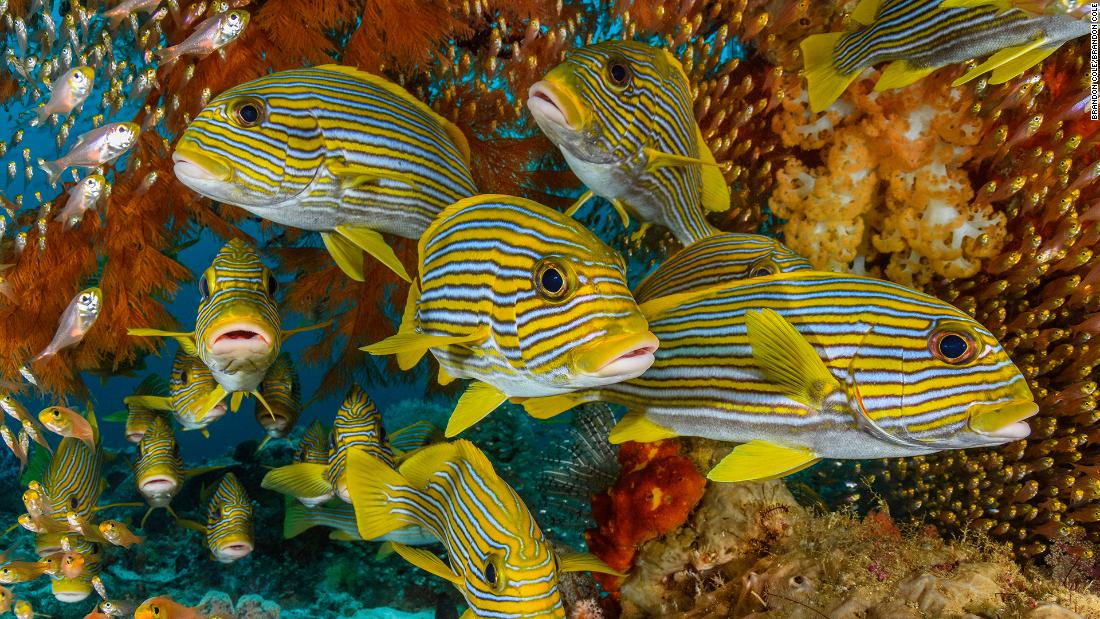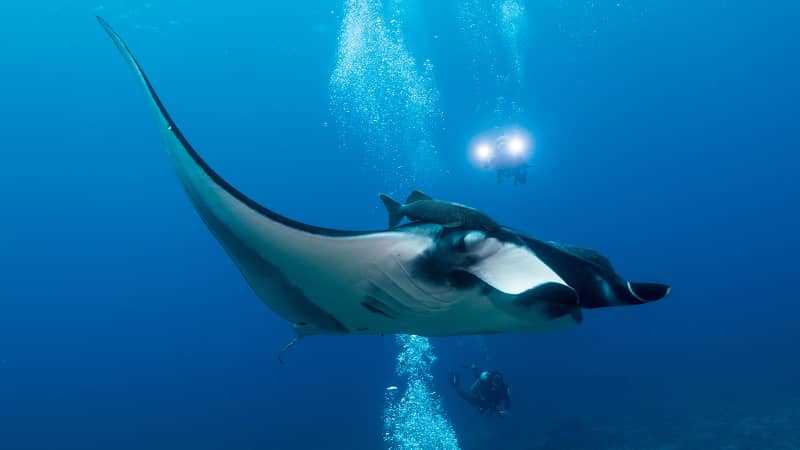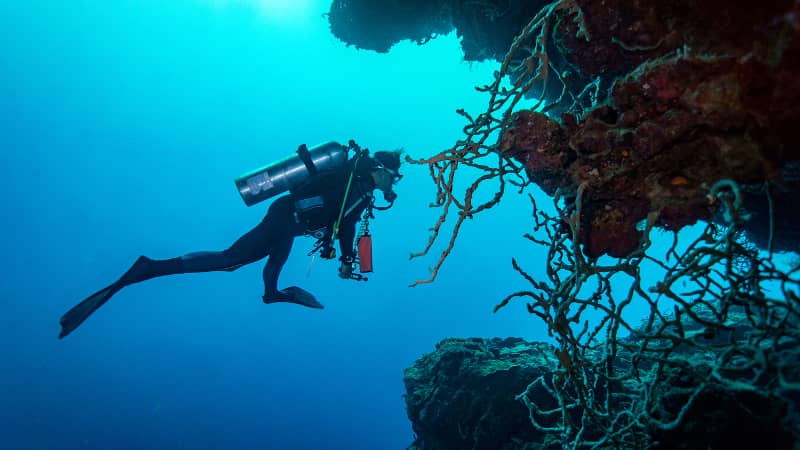(CNN) — If only salt water — sweat, tears and the sea — really was the cure for everything, as Danish author Isak Dinesen once said. Then scuba diving would be just the antidote the world needed right now.
Until it’s finally safe to get out exploring the world again, however, you can dream of where to dive beneath the surface of the ocean for the most wonder-inducing views on the planet.
“There are so many aspects of scuba diving that may be beneficial in directing our minds away from worries, stresses and daily demands,” says clinical psychologist and PADI scuba diving instructor Laura Walton, who has dived everywhere from the South Pacific to Scotland.
“In modern life, we are constantly pulled into the past, present and future through our ability to think,” she says. “But when we dive beneath the water, our attention is captivated by absorbing experiences of entering another world.”
Depending where you descend, that might mean finning through a “Christmas tree forest” of baby corals off the Florida Keys, coming face to face with a wall of sharks on a French Polynesia atoll or having a stare-down with a giant Pacific octopus in the cold waters of British Columbia.
The world’s most intriguing dive destinations take intrepid to the next level.
Raja Ampat, Indonesia
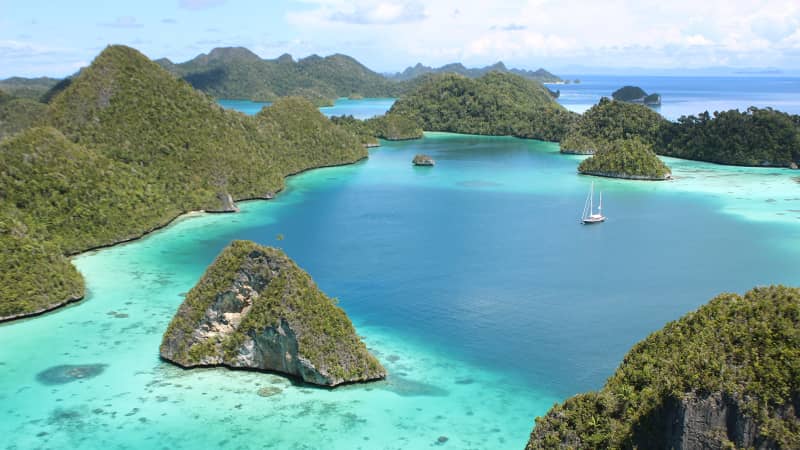
Raja Ampat is home to some of the highest marine biodiversity in the world.
Shutterstock
Bali brings the traveling masses to Indonesia. But intrepid scuba divers know to hop another flight east in the archipelago to West Papua, where some of the very best diving on the planet awaits in Raja Ampat.
The clear warm waters of the marine protected areas here are home to over 1,300 species of reef fish and veritable fields of corals that are among the most pristine in the world.
“You can come back and say you saw nine species of anthias, five species of pygmy seahorses,” says Cole, “Indonesia overall has continued to over-impress fish and coral geeks. But Raja Ampat deserves its position at the top.”
Tuamotu Atolls, French Polynesia
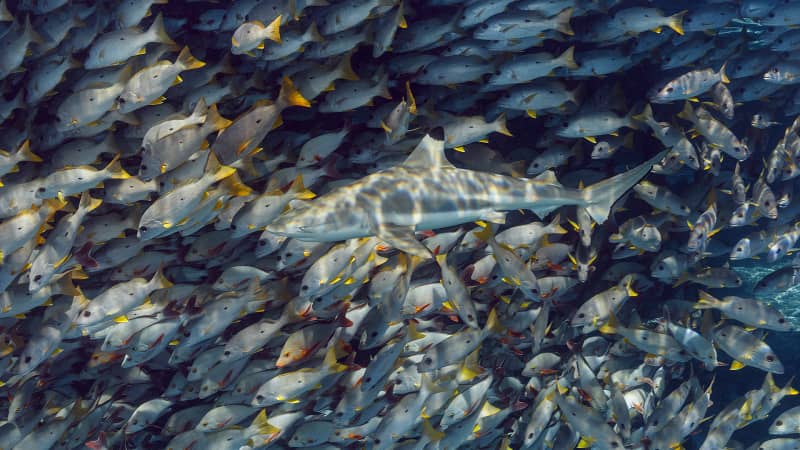
A blacktip reef shark swims alongside a school of one-spot snappers in French Polynesia.
Photo © Brandon Cole
After admiring one of the most impressive and reliable shark aggregations in the world, let the current push you into the atoll’s calm, turquoise lagoon, where you might spot a manta ray winging its way across the pristine coral beds.
Palau, Micronesia
But until you’ve submerged underwater in this marine wonderland located some 500 miles east of the Philippines in Micronesia, you haven’t seen Palau at all.
The most famous Palau dive site, Blue Corner, is a reef that juts out into the open ocean, with big upwellings that attract passing pelagic fish, reef sharks and schooling clouds of pyramid butterfly fish, among many other species.
Local Palau wildlife guide, marine biologist and diver Ron Leidich has called Blue Corner an “underwater Serengeti,” so riveting is the experience of diving in such an abundant confluence of marine life.
Divers use a “reef hook” at sites like Blue Corner to tether themselves to rocks to watch the spectacle of passing reef sharks and clouds of tropical fish in what are often strong currents.
“Palau is hands down the best place we’ve ever been diving,” says diver Frances Gulick, of Dallas, Texas, who usually takes several dive trips a year with her husband. “Nothing compares to watching sharks hunting in front of you while a resident Napoleon wrasse photobombs like a puppy dog of the sea.”
Fiji
“There’s something about that Fiji blue water and the yellow, red, purple, green and pink background of the coral reefs and walls that makes the whole scene look like it was painted by an impressionist master,” says Cole, “With anthias and fairy basslets schooling on many of the reefs, it’s as close to diving in a kaleidoscope as you can get. A truly fractal experience.”
Famed dive sites like Beqa Lagoon on Viti Levu, Fiji’s main island, draw shark divers to mingle with shark wranglers and eights specie of sharks, with regular tiger and bull shark sightings.
Chuuk Lagoon, Micronesia
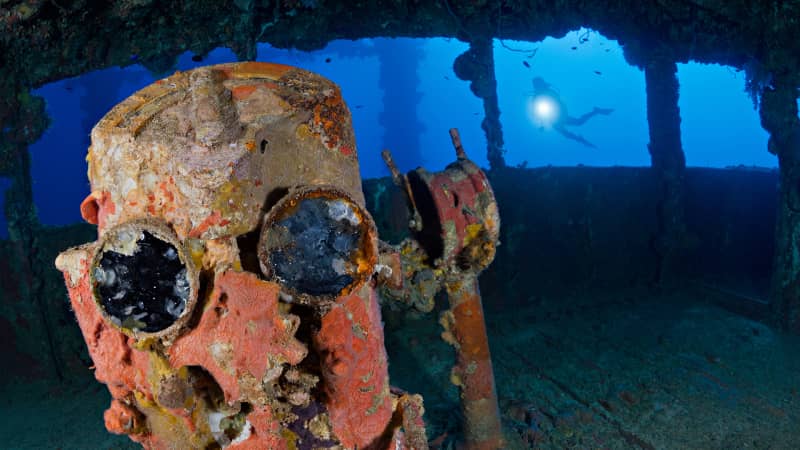
Machinery is seen inside the bridge of the Nippo Maru shipwreck, one of the famous dive sites in this Graveyard of the Pacific.
Photo © Brandon Cole
One of the world’s top destinations for keen wreck divers is Chuuk Lagoon (previously called Truk Lagoon) in Micronesia, where over 60 Japanese warships were sunk during World War II by the US Navy in Operation Hailstone of 1944.
The violence that rained down on this beautiful corner of the world is palpable even under water, where the bones of Japanese victims can still be seen fused to the steel wrecks. But the profusion of coral life carpeting cargo holds and crawling up the sunken masts and the clouds of tropical fish swirling all around you drive home the message that life, indeed, goes on.
If you dive just one wreck, make it the 500-foot-long Shinkoku Maru, a former Japanese fuel supply ship covered with a rainbow profusion of sponges, soft corals and anemones.
Key Largo, Florida Keys
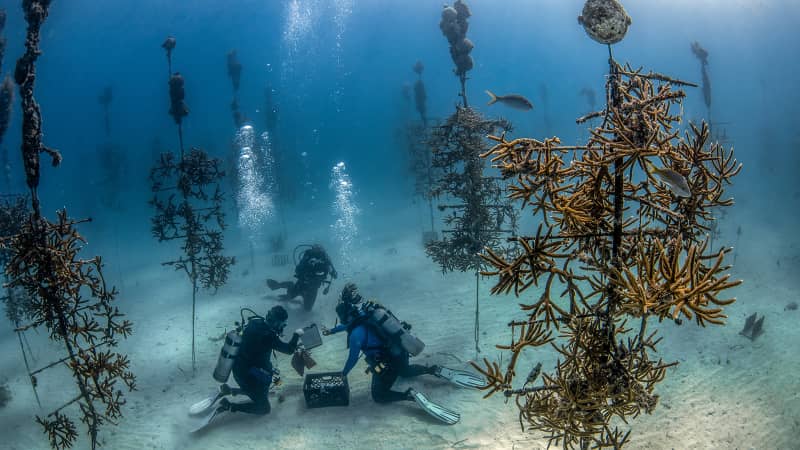
The Coral Restoration Foundation in Key Largo has offshore coral nurseries for reef restoration.
Courtesy of Coral Restoration Foundation
The organization’s largest coral tree nursery covers 1.5 acres of sea floor and has more than 500 coral trees holding 60 to 100 corals each.
“Corals are critical for creating habitat for all the marine life we like to see,” says Alice Grainger, communications director for the CRF. “All our genotypes were originally collected in the wild, so they’re very hardy. The corals we’re returning to the reef are thriving.”
And diving through a coral nursery, says Grainger, is a singular experience. “It’s like swimming through a forest of coral Christmas trees.”
Vancouver Island, British Columbia
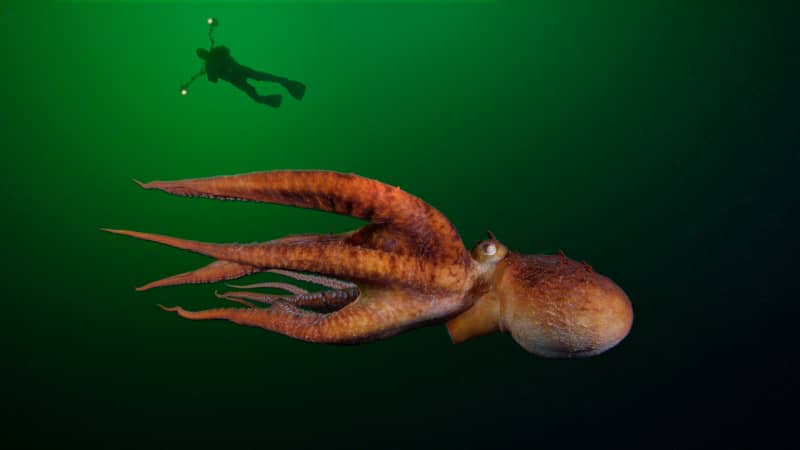
At about 110 pounds, the giant Pacific octopus is the world’s largest.
Photo © Brandon Cole
“If it wasn’t for that 45 to 50 degree Fahrenheit water, you could easily trick yourself into thinking you’re seeing the colors of the tropics here,” he says, “The invertebrates — soft corals, anemones and sea sponges — are particularly colorful.”
Two bucket list cold water critters divers come here to see are wolf eels and the giant Pacific octopus — the largest octopus in the world that averages about 110 pounds and 16 feet across.
“So much of the area is swept by strong currents that act as a conveyor belt for the nutrients and oxygen that supercharge marine life,” says Cole, “Learning how to dive the tides is key to enjoying what Vancouver Island has to offer.”
Sea of Cortez, Baja, Mexico
It’s impossible to talk about diving in the Sea of Cortez (also known as the Gulf of California) without name-dropping a legend. After all, it was Jacques Cousteau himself who referred to the rich waters between the Baja California Peninsula and Mexico’s mainland as “the world’s aquarium.”
Encounters with friendly California sea lions (the juveniles have a tendency to playfully nip at divers’ fins) are the most common lure when it comes to in-water interactions. But the more than 800 species of fish and animals that call these waters home also include manta rays, whale sharks, schooling hammerheads and megapods of dolphins.
Cocos Island, Costa Rica
Diving by liveaboard dive boats is the only way to access Cocos Island, a remote Pacific Ocean island that belongs to Costa Rica and lies some 330 miles off the mainland.
“Enchanting is a word that gets kicked around a lot in travel, but if a jungle island ringed with waterfalls right out of Jurassic Park where every dive is a shark dive doesn’t do it for you, I don’t know what will,” says Mary Frances Emmons, editor-in-chief of Scuba Diving magazine.
Cocos Island is an eastern Pacific way station for every kind of creature, she says, from Galapagos and hammerhead sharks to parrot fish, squirrel fish, rays and jacks by the thousands.
“We got lucky near the end of our dive when we stumbled on a pack of white tip sharks in a hunting frenzy not far from the surface,” she recalls, “An unusual daytime glimpse at a top nighttime attraction in Cocos.”
Bahamas
Divers kneel on the sandy bottom at the dive site called Tiger Beach, where tiger sharks come in close off the western end of Grand Bahama during one of the Bahamas’ most legendary dives. And Cole says there’s no better place than here to see the striped apex predators.
But many other apex sharks can be regularly seen and dived with in the mouthwash-clear waters of the Bahamas, too, he says, including great hammerheads, lemon sharks, bull sharks and oceanic whitetips.
Add to that adrenalin rush the Bahamas’ many shipwrecks, plunging walls and the chance to regularly snorkel with wild dolphins off islands like Bimini and you’ve got the all makings for an epic adventure a short jaunt from the US.
Solomon Islands
The world’s most fascinating dive destinations blow you away below the water and then again when you surface, too.
A cultural mix of Melanesian, Polynesian and Papuan influences swirl on land. And for divers, there are endless shipwrecks, downed airplanes and even sunken submarines to explore during expeditions via liveaboard dive boats or from land-based eco resorts.
Add to that abundant fish life, pristine pastures of hard coral and authentic village visits, and you’ll find culture, history and marine biology intertwined at every turn.
National Park Revillagigedo, Mexico
Most divers, however, are drawn to the area for intimate encounters with giant oceanic manta rays, which typically have wingspans of 23 feet. “But interactions with wild bottlenose dolphins in the water here have become just as good,” says Higuera.
Poor Knights Islands, New Zealand
New Zealand’s topside views (most from the South Island) get the lion’s share of the Hollywood love.
Home to thick kelp forests, the waters here don’t exactly beckon like Bali (during the southern hemisphere summer, water temperatures average about 72 degrees). But it’s precisely the mix of New Zealand’s cooler ocean waters mixing with warm currents swept south from the Coral Sea that make for the unusual denizens that cruise the Poor Knights.
“Biologically it’s neat because it’s a mixing of cold and warm water critters,” says Cole, which means you might see parrot fish, moorish idols and sea turtles alongside cool water critters like scorpion fish and the ubiquitous blue and pink maomaos (colorful fish that tend to congregate in arches and shadowy grottoes).
“Folks go to New Zealand for green travel and to be outside, but very few go below the water line,” says Cole, “And the water in the Poor Knights is truly tropical blue.”
Red Sea, Egypt
Here, off the tip of the Sinai Peninsula between Africa and the Middle East at Egypt’s Ras Mohammed National Park, you’ll find some of the clearest seas on the planet for scuba diving (there is almost no natural runoff from the Sinai to cloud the surrounding waters).
Extraordinary walls of healthy hard corals abound. And around Dahab and Sharm al Sheikh you can access many dive sites right from the shore, with no boat required.
“Orange anthias are everywhere and not shy with divers, who may also find themselves surrounded by angelfish, butterflyfish and colorful broadtail and Napoleon wrasse,” says Emmons.
Wreck divers delight in descending on the famous British Navy ship SS Thistlegorm, the Red Sea’s most popular wreck. Emmons says to add the former cargo ship, the Giannis D, to your wreck wishlist, too.
“it’s a playfully disorienting jungle gym that suggests diving in an M.C. Escher drawing, come to life,” she says.
Dominica
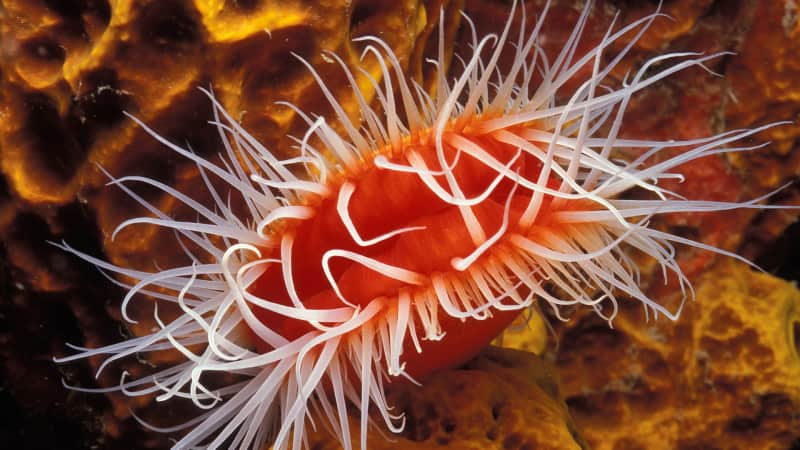
A rough fileclam mesmerizes in the waters off Dominica.
Photo © Brandon Cole
But in addition to its coral-clad walls and reefs, Dominica offers something many Caribbean islands can’t — the chance to swim with resident sperm whales that frequent the waters during specially permitted boat trips.
Even if you come to the Caribbean’s Nature Island just to dive the reefs, however, you won’t leave disappointed. And the place to see the corals and fish life at their best is within the protected Soufriere-Scotts Head Marine Reserve on the island’s southwest tip.
Portugal
Divers needn’t venture far beyond Lisbon for some of mainland Europe’s most dazzling underwater views.
Much farther offshore, the volcanic archipelago of the Azores delivers with open ocean dives and sightings of the resident sperm whales. At the submerged seamount called Princess Alice Banks in the Azores, shoals of mobula rays swim in circles around the pinnacle at a depth of around 90 feet in what can only be described as a vortex of wonder.
